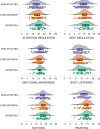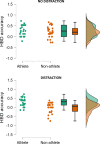Interoceptive differences in elite sprint and long-distance runners: A multidimensional investigation
- PMID: 36696380
- PMCID: PMC9876362
- DOI: 10.1371/journal.pone.0278067
Interoceptive differences in elite sprint and long-distance runners: A multidimensional investigation
Abstract
Interoception, the process of detecting and interpreting bodily sensations, may facilitate self-regulation and thereby play a crucial role in achieving elite performance in competitive sports. However, there is a lack of research conducted in world-class athletes. In the present research, two studies examined self-reported (interoceptive sensibility) and behavioural (interoceptive accuracy) interoception in elite (top 100 ranking) sprint and long-distance runners, and non-athletes. Study 1 used the Multidimensional Assessment of Interoceptive Awareness Questionnaire. Sprinters reported having better regulation of attention to internal sensations, greater emotional awareness, better self-regulation, and reported a greater propensity to listen to their body for insight, than distance runners. Compared to non-athletes, sprinters and distance runners had more bodily trust, attention regulation, and self-regualtion. Additionally, elite athletes reported lower emotional awareness, self-regulation, and body listening. Study 2 examined cardioception using two tasks: The Heartbeat Counting Task, and The Heartbeat Detection Task. Elite and non-elite runners performed the tasks under two conditions; in silence, and whilst listening to pre-recorded crowd noise that simulated the live sounds of spectators during a sporting event. Sprinters and distance runners were able to maintain heartbeat detection accuracy when distracted, whereas non-athletes could not. Across both tasks, compared to non-athletes, sprinters and distance runners were more confident than non-athletes in their interoceptive percept. Additionally, elite athletes compared to non-elite athletes were less accurate when counting their heartbeat and were characterised by a higher interoceptive prediction error. Athletic populations have altered interoceptive abilities.
Copyright: © 2023 Seabury et al. This is an open access article distributed under the terms of the Creative Commons Attribution License, which permits unrestricted use, distribution, and reproduction in any medium, provided the original author and source are credited.
Conflict of interest statement
The authors have declared that no competing interests exist.
Figures






Similar articles
-
Validation of the shortened 24-item multidimensional assessment of interoceptive awareness, version 2 (Brief MAIA-2).Sci Rep. 2023 Dec 2;13(1):21270. doi: 10.1038/s41598-023-48536-0. Sci Rep. 2023. PMID: 38042880 Free PMC article.
-
Difference in Interoception between Long-Distance Runners and Sprinters: An Event-related Potential Study.Med Sci Sports Exerc. 2020 Jun;52(6):1367-1375. doi: 10.1249/MSS.0000000000002248. Med Sci Sports Exerc. 2020. PMID: 32432844
-
Exploring Individual Differences in Interoception Among Athletes Based on a Three-Dimensional Construct of Interoception.Psychophysiology. 2025 Jan;62(1):e14766. doi: 10.1111/psyp.14766. Psychophysiology. 2025. PMID: 39865370
-
Differentiating attention styles and regulatory aspects of self-reported interoceptive sensibility.Philos Trans R Soc Lond B Biol Sci. 2016 Nov 19;371(1708):20160013. doi: 10.1098/rstb.2016.0013. Epub 2016 Oct 10. Philos Trans R Soc Lond B Biol Sci. 2016. PMID: 28080970 Free PMC article. Review.
-
Dissociations between self-reported interoceptive accuracy and attention: Evidence from the Interoceptive Attention Scale.Biol Psychol. 2022 Feb;168:108243. doi: 10.1016/j.biopsycho.2021.108243. Epub 2021 Dec 18. Biol Psychol. 2022. PMID: 34929353 Review.
Cited by
-
Validation of the shortened 24-item multidimensional assessment of interoceptive awareness, version 2 (Brief MAIA-2).Sci Rep. 2023 Dec 2;13(1):21270. doi: 10.1038/s41598-023-48536-0. Sci Rep. 2023. PMID: 38042880 Free PMC article.
-
Interoception, cardiac health, and heart failure: The potential for artificial intelligence (AI)-driven diagnosis and treatment.Physiol Rep. 2025 Jan;13(1):e70146. doi: 10.14814/phy2.70146. Physiol Rep. 2025. PMID: 39788618 Free PMC article. Review.
-
The relationship between mindfulness and athletes' mental skills may be explained by emotion regulation and self-regulation.BMC Sports Sci Med Rehabil. 2024 Mar 19;16(1):68. doi: 10.1186/s13102-024-00863-z. BMC Sports Sci Med Rehabil. 2024. PMID: 38504372 Free PMC article.
-
Supported to perform: sports bras and breast volume do not impair cycling performance in females.Front Sports Act Living. 2024 Oct 11;6:1439403. doi: 10.3389/fspor.2024.1439403. eCollection 2024. Front Sports Act Living. 2024. PMID: 39465208 Free PMC article.
References
MeSH terms
Associated data
LinkOut - more resources
Full Text Sources

